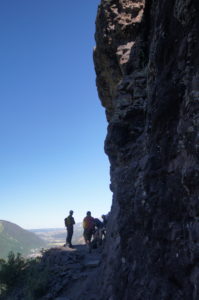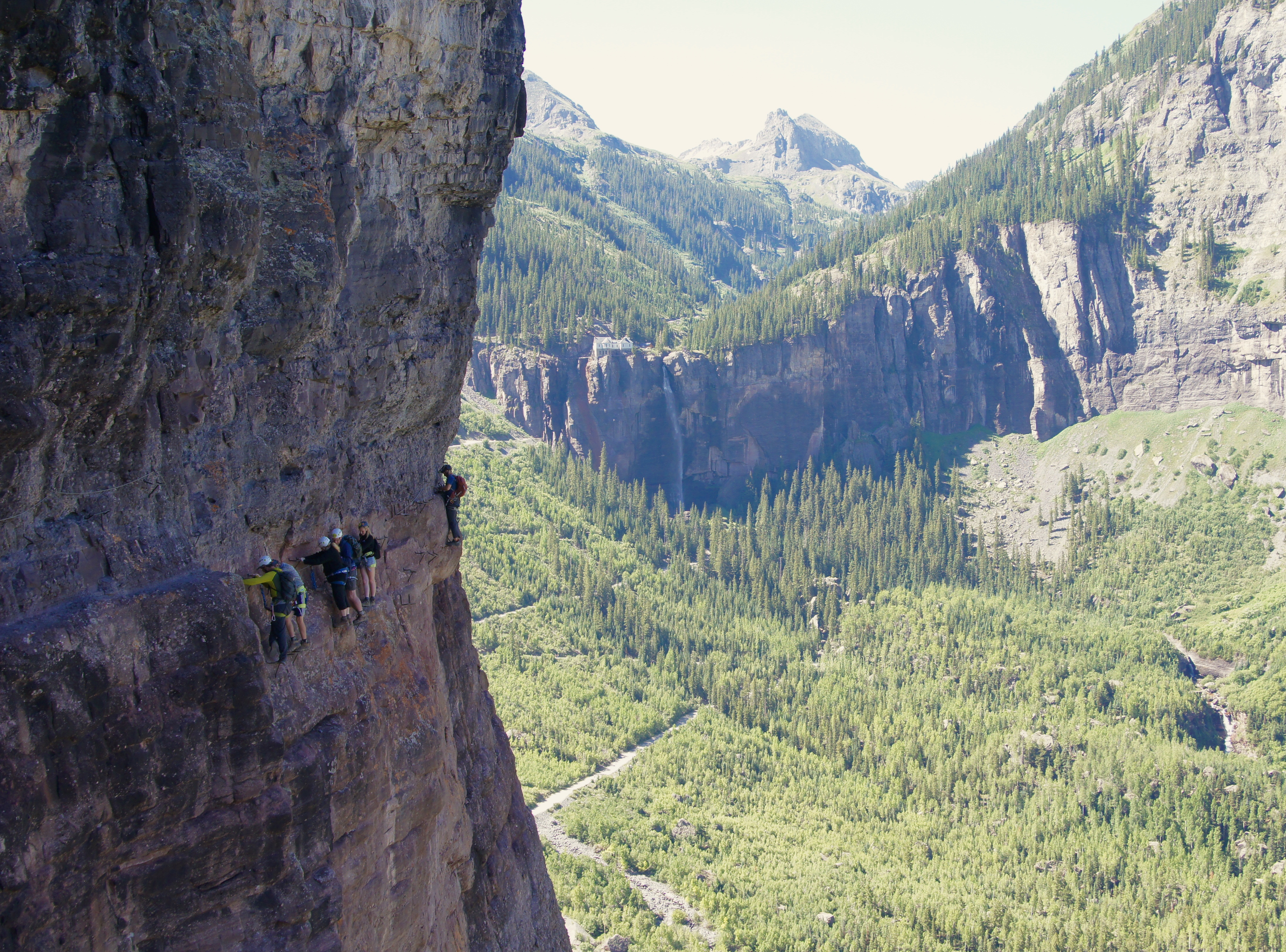The path before me, etched into a shadowy gray massif high in the Rocky Mountains, is narrowing — two feet wide, one foot, six inches and then . . . nothing. My next step could take me into a column of air extending infinitely upward and, somewhat more concerning, more than 300 feet straight down.
I’m a couple of miles east of Telluride, Colo., on a cloudless July morning, halfway through a 1½ -mile traverse of thin trails, rock ledges and sheer cliffs at 10,000 feet. I am face to face with the most harrowing section of this passage, known as the Main Event, a roughly 100-foot crossing of a vertical wall.
This isn’t quite as daring as it sounds: The route is a via ferrata — Italian for “way of the irons” — and is augmented with more than 100 handholds and footholds of forged iron as well as intermittent sections of safety cables, one of which I am clipped to with pro-grade mountain climbing gear.

Guide Joshua Butson takes a break on the Telluride via ferrata, a mountaineering route that affords stunning views of the surrounding mountains and valley. (John Briley)
Still, neither the hardware nor my expert guide, the affable 40-year-old Joshua Butson, are providing much solace right now. My next move demands that I ignore the warning signals honed over eons of human evolution and step — voluntarily — onto a finger-width iron rung bolted into a vertical cliff wall, then link a combination of rung and rock holds across said wall before the path resumes.
My heart is pounding, my mouth feels like the Sahara and my knee is a cellphone stuck on vibrate. The rungs and cable I had trusted so implicitly to this point now look like toothpicks, ready to snap with the next ounce of pressure. With a deep breath and the tunnel vision of a man about to die, I will my left leg off the ledge and commit.
Via ferrate are found on mountain terrain around the world. Some feature ladders, walkways, handrails and even bridges. These protected routes date back centuries, with the more modern ones traced to World War I, when the Italian and Austro-Hungarian armies set hundreds of them to move troops and supplies through the Dolomites. Following the war, many of those routes lay dormant until the 1960s and ‘70s, when mountaineers began using — and improving — them for recreation.
Among those climbers was Chuck Kroger, a Telluride-based adventurer and self-taught welder who, after numerous mountaineering forays around the world, decided his hometown needed a via ferrata.
“Need,” of course, is relative, as Telluride was already an outdoor fairy-tale playground. Tucked into an impossibly scenic box canyon at 8,700 feet above sea level, the former mining camp sits at the foot of a world-class ski resort and hundreds of miles of hiking, running, biking and mountaineering routes. A solid cadre of the wayward hippies and ski bums who alighted here in the 1970s and ’80s endures, but Telluride, like so many hamlets in the Mountain West, long ago caught the eye of the gilded class, a reality reflected in the seven-figure price tags on even the smallest flower-laced Victorians along the tree-lined streets. But with the natural bounty and a mix of mid- and high-range restaurants, bars and shops, Telluride remains a stunning and invigorating place to visit.
In 2006, after Kroger had zeroed in on ledges on U.S. Forest Service land along the 12,785-foot Ajax Peak, he began forging iron rungs one at a time in his shop and, not wanting to draw attention, slipping up onto the wall at night with a headlamp and battery-powered drill to bolt them and the cable anchors into place. On Christmas Day 2007, mere weeks before he could finish the installation, Kroger died of pancreatic cancer. But friends completed what he had started. By late summer 2008, the Telluride via ferrata was in use — a secret escape for locals.
Per Kroger’s vision, the route presents artificial holds “only where needed,” a subjective metric that, if you must know, nobody ran by me during the planning phase.
Now it’s too late to protest: I am plastered to the wall, feet together on one rung and hands clutching another, as I ponder how long the human leg can shudder uncontrollably.
“How’re you doing?” asks Butson, who is three moves ahead of me with one hand dangling at his side, like Spider-Man on a kiddie jungle gym.
“Nervous!” I concede.
“Good!” he smiles. “If you weren’t, I’d be worried about you. You’re doing great, by the way.”
The exchange, coupled with Butson’s earlier comment that his company has a perfect safety record on the via ferrata, calms me and I continue on to the toughest move of the day: the Crux, which entails stepping around a protrusion of rock while shifting my handholds from head high to waist level, a particularly awkward maneuver for someone with no faith in the afterlife.

The author, looking far more relaxed than he actually is on the Main Event, the most exposed section of the Telluride via ferrata — an extreme mountaineering experience. (Joshua Butson)
The via ferrata is an ideal outing for people like me — outdoor-loving adrenaline seekers who tend to grow bored on long hikes but lack the skill required for technical rock climbing. Much of this route indeed qualifies as hiking, with the critical caveat that the trail often features a ribbon of off-camber mountain dust and there are many, many spots where an unclipped slip could send one skittering over a cliff. (To date, no deaths, serious injuries or rescues have occurred up here.)
All of which makes safety paramount. Before we started, Butson fitted me with harness and helmet, and had me practice clipping and unclipping the carabiners that I would affix to the cables. I also observed the guides in the parties behind and ahead of us patiently coaching clients through dicey spots, although one guide launched a drone in a highly exposed section, a move that Butson decried as an annoying and potentially hazardous distraction.
And this is not a place you want to be distracted. Just a few yards after we started, I almost shattered Butson’s perfect safety record. Captivated by a sweeping view of the town far below, cradled by slopes of spruces, firs and aspens, I stumbled, the kind of minor wobble that might happen while walking down a sidewalk. Already clipped to a section of cable, I overreacted and lurched for something to grab, lashing my knuckles on the underside of the cable. Butson, 15 feet ahead, was blissfully unaware I had even tripped and, if it’s okay with you, I’d like to keep it that way.
On the one hand, I’m surprised that a protected route would prove so popular in Telluride, a town brimming with mountain athletes whose audacious feats suggest they could whistle through the via ferrata blindfolded on a unicycle.
But the allure is strong, even for locals, says resident Todd Rutledge, who has done the route more than 50 times, mostly as a guide. “Every time I come around that corner [to the Main Event], I get butterflies,” he says. “The via ferrata allows people living ordinary lives to put themselves in a place that is wildly unnatural to humans. We coach people though it every day when they freeze up, and they emerge literally transformed. We get a lot of hugs at the end of the via ferrata.”

While a lot of people are doing it — at least 6,000 did in 2017, according to a register that the ferrati sign their names in along the route — a video on the Telluride Mountain Club’s website cautions: “This route is not appropriate for small children, very short adults [4-foot-11 or under, Rutledge says] or people who don’t enjoy heights or exposure. And don’t even think about bringing your dog up here.”
(Rutledge says he saw a group last year toting a midsize dog, wearing a full harness, on the iron way — a seriously ill-advised decision.)
Buoyed by the adrenaline rush of the Main Event and the return to solid ground, I start to practically skip along the ledge, but Butson cautions me against nonchalance: Although the trail is bordered in places by small conifers, the spaces beyond them are precisely that — space — and a slip could be fatal.
The trail then takes us into gorgeous, Grand Canyon-like embayments in the mountainside and onto promontories overlooking the valley, the slopes of Telluride Ski Resort (verdant even in a tinder-dry summer) and towering walls of red sandstone. Before making it to the creek drainage that will lead us out, we hit two more dicey sections. One is called the Monkey Bars, where I transition through some rungs with feet on wall and butt stuck wayout, and another counter-instinctual lean over yet one more sheer drop.
After unclipping for the last time, three hours after our start, we hike down through a grove of aspens and beneath old mining infrastructure, some of it built in places that make the via ferrata transit look like a Sunday stroll. But, of course, it isn’t.
“One of the hardest things I’ve ever done,” says a 30-ish woman from Phoenix when I meet her back at the road. “I’m glad it’s over, but I’m really glad I conquered it!”
When I catch up with my wife and kids as they spin-cast for rainbow trout in a stocked pond in Telluride’s idyllic Town Park, I point up at the looming rock wall. “Look where Dad just was!”
My 6-year-old daughter Christina glances up.
“Was it scary?”
I give her a smile.
“What do you think?”

Comments